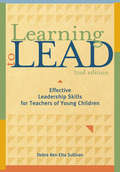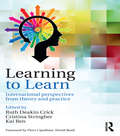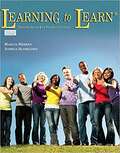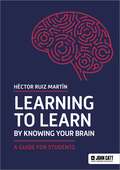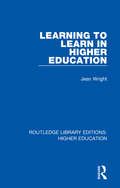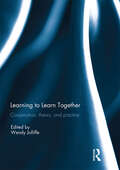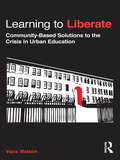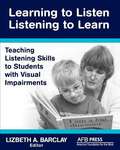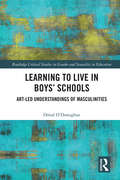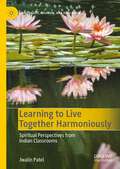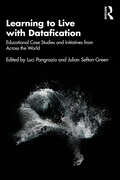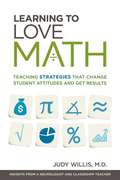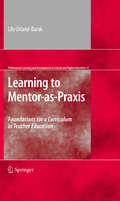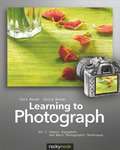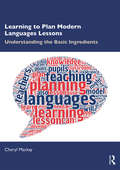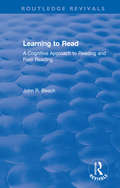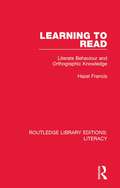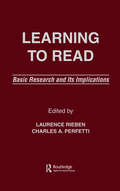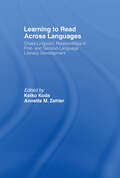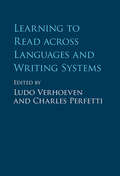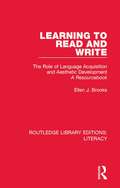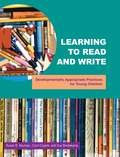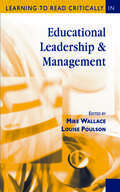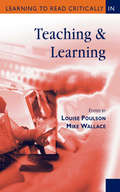- Table View
- List View
Learning to Lead, Second Edition
by Debra Ren-Etta SullivanLearning to Lead combines theory and practice with important topics such as human development, diversity, anti-bias, and social change. New to this edition is information on leadership connections in school-age care and nurturing leadership in children. Each chapter is designed to prompt self-evaluation and personal leadership development.
Learning to Learn: International perspectives from theory and practice
by Ruth Deakin Crick Cristina Stringher Kai RenLearning to Learn provides a much needed overview and international guide to the field of learning to learn from a multidisciplinary lifelong and lifewide perspective. A wealth of research has been flourishing on this key educational goal in recent years. Internationally, it is considered to be one of the key competencies needed to compete in the global economy, but also a crucial factor for individual and social well-being. This book draws on leading international contributors to provide a cutting-edge overview of current thinking on learning to learn research, policy, and implementation in both formal and informal learning environments. But what learning to learn is exactly, and what its constituting elements are, are much debated issues. These seem to be the crucial questions if assessment and development of this 'malleable side of intelligence' are to be accomplished. The approach of this volume is to consider a broad conception of learning to learn, not confined to only study strategies or metacognition, yet acknowledging the importance of such elements. The book sets out to answer five main questions: What is learning to learn? What are its functions and how do we assess it? What does it promise to the individual and society at large? How is it conceived in national curricula internationally? How can it be developed in a variety of contexts? The text is organized into two parts: the first addresses the core question of the nature of learning to learn from a theoretical and policy viewpoint, and the second presents recent research carried out in several educational systems, with special attention to assessment and curriculum. It gives an account of pedagogical practices of learning to learn and its role in individual empowerment from childhood to adulthood. Contributors also highlight the potential use of learning to learn as an organizing concept for lifelong learning, school improvement, and teacher training along with potential conflicts with existing incentive practices and policies. This book is a vital starting point and guide for any advanced student or researcher looking to understand this important area of research.
Learning to Learn: Thinking Skills for the 21st Century
by Marcia Heiman Joshua SlomiankoLearning to Learn is the only college-level program the Department of Education has found to have valid, controlled studies showing significant, lasting impacts on students grade point averages and retention through graduation. These studies show 80% graduation rates at colleges and 20% improvement in retention at four-year colleges. The skills in this book come easily to students because they re built on natural learning skills the skills used every day. Learning to Learn brings back the feeling of excitement about learning new things that students had before school and tests. They learn to build on their natural questioning skills and translate back and forth between what they see and what they think about between verbal and visual learning.
Learning to Learn by Knowing Your Brain: A Guide for Students
by Héctor Ruiz MartínDid you know that science has revealed what actions and circumstances make your brain learn more effectively?In this book, a scientist explains in a simple and very entertaining way how your brain learns and what you can do to take advantage of its full potential.Among other things, you will find out that:- Both people who are good at learning and those who are not can improve their performance if they use the right learning strategies: those that align with the way the brain learns best!- Most students do not know these strategies and those who spontaneously develop them gain a huge advantage without even realizing it.- Your brain is much more powerful than you realize in terms of its ability to learn. Every time you learn something, your brain changes its structure!When you learn about how the brain learns, you learn to learn!
Learning to Learn by Knowing Your Brain: A Guide for Students
by Héctor Ruiz MartínDid you know that science has revealed what actions and circumstances make your brain learn more effectively?In this book, a scientist explains in a simple and very entertaining way how your brain learns and what you can do to take advantage of its full potential.Among other things, you will find out that:- Both people who are good at learning and those who are not can improve their performance if they use the right learning strategies: those that align with the way the brain learns best!- Most students do not know these strategies and those who spontaneously develop them gain a huge advantage without even realizing it.- Your brain is much more powerful than you realize in terms of its ability to learn. Every time you learn something, your brain changes its structure!When you learn about how the brain learns, you learn to learn!
Learning to Learn in Higher Education (Routledge Library Editions: Higher Education #35)
by Jean WrightOriginally published in 1982, Learning to Learn in Higher Education analyses the factors that govern effective student learning and looks at the way that these can be improved by changing the way that courses are administered. It examines preparation for higher education and the effect of school systems on the individual student. In acknowledging the academic importance of motivation, maturity and effective study methods it discusses the way that these can be developed and encouraged within the present educational system. In determining the goals of higher education in the 1980s and beyond, it is important that financial considerations, the clamour of industry for vocational courses, the development of technological-scientific research does not obscure the needs of the individual learner.
Learning to Learn together: Cooperation, theory, and practice
by Wendy JolliffeThis book brings together a range of international studies to support the implementation of cooperative group work in the classroom. In spite of extensive research into the benefits of this approach, in many countries, it is not widely used, largely due to a lack of understanding of how to put this into practice in the classroom. Starting from an exploration of the theoretical perspectives that underpin this pedagogy, the challenges for including pupils with special educational needs and related status issues of pupils are explored. Amongst the themes explored are how creative approaches, such as Storyline, support engagement particularly for second language learning; how working with young children using cooperative group work can develop writing skills; and how teachers can work together in an effective, collaborative, and sustained manner in a professional learning community. The final chapter provides a vivid example of one teacher’s personal journal to develop her understanding of the power of cooperation in creating bridges to meaningful learning for all learners. This book was originally published as a special issue of Education 3-13.
Learning to Liberate: Community-Based Solutions to the Crisis in Urban Education (Critical Social Thought)
by Vajra WatsonFew problems in education are as pressing as the severe crisis in urban schools. Though educators have tried a wide range of remedies, dismal results persist. This is especially true for low-income youth of color, who drop out of school—and into incarceration—at extremely high rates. The dual calamity of underachievement in schools and violence in many communities across the country is often met with blame and cynicism, and with a host of hurtful and unproductive quick fixes: blaming educators, pitting schools against each other, turning solely to the private sector, and ratcheting up the pressure on teachers and students. But real change will not be possible until we shift our focus from finding fault to developing partnerships, from documenting problems to discovering solutions. Learning to Liberate does just that by presenting true and compelling community-based approaches to school reform. Drawing on over three years of ethnographic research, Vajra Watson explores the complicated process of reaching and teaching today's students. She reveals how four nontraditional educators successfully empower young people who have repeatedly been left behind. Using portraiture, a methodology rooted in vivid storytelling, Watson analyzes each educator's specific teaching tactics. Uncovering four distinct pedagogies—of communication, community, compassion, and commitment—she then pulls together their key strategies to create a theoretically grounded framework that is both useful and effective. A poignant, insightful, and practical analysis, Learning to Liberate is a timely resource for all educators and youth-serving practitioners who are committed to transforming "at-risk" youth into "at-promise" individuals who put their agency and potential into action in their schools and neighborhoods.
Learning to Listen/Listening to Learn
by Lizbeth A. BarclayLearning to Listen/Listening to Learn is the first comprehensive work to address the systematic development of skills in listening for and interpreting auditory information for students who are blind or visually impaired. Listening skills are a crucial but often-overlooked area of instruction for children who are visually impaired and may have multiple disabilities, essential to literacy, independent travel, and sensory and cognitive development. Chock full of practical strategies, this volume examines the development of and instruction in learning skills at different ages, from infancy through high school. It also addresses listening skills in orientation and mobility and the needs of children with multiple disabilities, hearing impairment, and learning disabilities, as well as English language learners. Appendixes provide a Listening Skills Continuum chart and a checklist to use in assessment.
Learning to Live in Boys’ Schools: Art-led Understandings of Masculinities (Routledge Critical Studies in Gender and Sexuality in Education)
by Donal O'DonoghueThis book is about boys’ experiences of being educated in independent single-sex schools in Canada. These experiences, which are oftentimes attributed to particular places and moments at school, reveal ways in which school places are both "companionable" and "influential" in how boys become available to themselves and others as they pursue the possibility of becoming somebody. Curious about how masculinities show up in places at school and studying the sorts of gendered subjectivities that such places invite, entice, support and deny, the book extends beyond traditional ways of thinking and writing about the production of masculinities in education by introducing a different set of conceptual orientations and inquiry practices, including post-masculinities, weak theory, and art-led research and thought practices.
Learning to Live Together Harmoniously: Spiritual Perspectives from Indian Classrooms (Spirituality, Religion, and Education)
by Jwalin PatelThis book calls for an expanded vision of holistic education that emphasizes togetherness and harmony through the discovery of oneself, others, and the larger society. It brings together teachers’ voices, experiences, and practices for such an education with Southern Knowledge, philosophy and ideologies proposed by Indian philosophers and spiritual leaders like Aurobindo, the Dalai Lama, Gandhi, Krishnamurti, and Tagore. The book reconceptualizes and extends UNESCO's "Learning To Live Together" to emphasize "Learning to Live Together Harmoniously" (LTLTH) and develops a novel conceptual framework for it. The book also explores how LTLTH can be translated into practice; calling for a continuum of harmonious lived experiences created through experiential and project based pedagogy, systems and processes for autonomy and autonomous behaviour regulation, empathetic teacher student relations, schoolwide ethos of harmonious living, and teachers’ ways of living and being.
Learning to Live with Datafication: Educational Case Studies and Initiatives from Across the World
by Luci Pangrazio Julian Sefton-GreenAs digital technologies play a key role across all aspects of our societies and in everyday life, teaching students about data is becoming increasingly important in schools and universities around the world. Bringing together international case studies of innovative responses to datafication, this book sets an agenda for how teachers, students and policy makers can best understand what kind of educational intervention works and why. Learning to Live with Datafication is unique in its focus on educational responses to datafication as well as critical analysis. Through case studies grounded in empirical research and practice, the book explores the dimensions of datafication from diverse perspectives that bring in a range of cultural aspects. It examines how educators conceptualise the social implications of datafication and what is at stake for learners and citizens as educational institutions try to define what datafication will mean for the next generation. Written by international leaders in this emerging field, this book will be of interest to teacher educators, researchers and post graduate students in education who have an interest in datafication and data literacies.
Learning To Love Math: Teaching Strategies that Change Student Attitudes and Get Results
by Judy WillisIs there a way to get students to love math? Dr. Judy Willis responds with an emphatic yes in this informative guide to getting better results in math class. Tapping into abundant research on how the brain works, Willis presents a practical approach for how we can improve academic results by demonstrating certain behaviors and teaching students in a way that minimizes negativity. With a straightforward and accessible style, Willis shares the knowledge and experience she has gained through her dual careers as a math teacher and a neurologist. In addition to learning basic brain anatomy and function, readers will learn how to* Improve deep-seated negative attitudes toward math. * Plan lessons with the goal of "achievable challenge" in mind. * Reduce mistake anxiety with techniques such as errorless math and estimation. * Teach to different individual learning strengths and skill levels. * Spark motivation. * Relate math to students' personal interests and goals. * Support students in setting short-term and long-term goals. * Convince students that they can change their intelligence. With dozens of strategies teachers can use right now, Learning to Love Math puts the power of research directly into the hands of educators. A Brain Owner's Manual, which dives deeper into the structure and function of the brain, is also included--providing a clear explanation of how memories are formed and how skills are learned. With informed teachers guiding them, students will discover that they can build a better brain . . . and learn to love math!
Learning to Mentor-as-Praxis
by Lily Orland-BarakThe concept of mentoring has undergone a major shift from guide/guided or instructor/protégé arrangements toward more reciprocal, collaborative models. Informed by a robust theoretical framework and real-life examples of successful and ineffective interactions, Learning to Mentor-as-Praxis analyzes in compelling detail how belief systems, ideologies, and values affect the mentoring relationship, why they are critical factors in today's multicultural landscape, and how they can be used in the training of the next generation of mentors. In this proactive framework, learning to mentor is less a process of acquiring discrete skills and more the gaining of an interrelated set of competencies. At the same time, the book emphasizes the evolution of professional development--pre-service, in-service, and higher education--by focusing on these areas: Sociocultural and contextual aspects of mentoring Literature review: acts and agency in mentoring Appreciation, participation, and improvisation: the key domains of praxis Building reciprocal interactions in dyads and groups Using challenges, paradoxes, and impasses Guidelines for designing and implementing a curriculum in mentor education A bold reappraisal of current theory and practice and a new conceptualization of mentoring as domains of appreciation, participation and improvisation in praxis, Learning to Mentor-as-Praxis belongs in every academic library and on the shelves of researchers and professionals in mentoring, teacher education, and curriculum development.
Learning to Photograph - Volume 2
by Cora Banek Georg BanekThe two volumes of the Learning to Photograph series give students and interested amateur photographers essential information about technique and design as well as an understanding of the big concepts of photography. Beginning and advanced photographers alike will find the content instructive, thoroughly explained, and effectively illustrated, making this book a useful resource for readers to develop their own craft. This second volume addresses the topics of visual design and composition. The authors describe various methods of visual design and how you can use these methods effectively. You will learn which techniques to use to design your images while at the same time training your photographic eye. You will develop the ability to support the message of your subject purposefully, hone your photographic style, and analyze your own work and the work of others competently. The striking images and informational graphics not only illustrate the concepts at hand, but also make the lessons visually pleasing and offer useful examples for readers to mimic in their own work. Topics include: Visual perception Composition, shapes, and lines Managing light Color and its effects Sharpness, blur, and movement The interplay of visual design elements Image analysis and evaluation The previous volume in the Learning to Photograph series addresses cameras, equipment, and basic photographic techniques.
Learning to Plan Modern Languages Lessons: Understanding the Basic Ingredients
by Cheryl MackayLearning to Plan Modern Languages Lessons contains a wealth of guidance and ideas for those learning to teach in secondary schools. Drawing on extensive experience and research in the field, it offers detailed explanation of basic lesson planning methods and the principles that underpin them, illustrated by worked examples of well-planned lessons. The book shows how to progress from planning smaller activities to full lessons to sequences of lessons, and how to ensure progression for your students. Specific aspects of language learning such as grammar and culture are explored, together with ideas for how to make your planning skills more effective in long-term collaborative and reflective practice. Starting from a presentation, practice, production (PPP) model of language teaching, the book aims to: provide structured, practical starting points in lesson planning for beginning teachers of modern languages (ML); deepen knowledge and understanding of ML as a subject and how it is learnt (pedagogical subject knowledge), in order to inform and support planning decisions; develop understanding of lesson planning as part of a planning cycle; enhance understanding of strategies and professional development opportunities to promote the further development of planning abilities. Including reflective/discussion tasks and example lesson plans Learning to Plan Modern Languages Lessons is a must-read book for beginning and more experienced teachers of any modern language.
Learning to Read: A Cognitive Approach to Reading and Poor Reading (Routledge Revivals)
by John R. BeechOriginally published in 1985, Learning to Read presents a balanced view of contemporary research into the reading process and theories accounting for reading and poor reading. The book focuses in particular on children who experience considerable difficulty in acquiring necessary reading skills. It considers how reading ability is assessed and the problematic subject of dyslexia. It also adopts a comprehensive approach to the cognitive factors behind poor reading, as well as possible developmental and environmental factors. Learning to Read will appeal to those with an interest in how children learn to read and the development of research on this subject.
Learning to Read: Literate Behaviour and Orthographic Knowledge (Routledge Library Editions: Literacy #6)
by Hazel FrancisOriginally published in 1982. This book charts the reading progress of ten children through their first three years at school, concentrating particularly on their problems and the ways they coped with them. The author uses these case studies to analyse the children's understanding, experience of behaviour associated with literacy, and developing knowledge of spelling in the early stages of learning to read. Her analysis of the children's difficulties and successes, against the background of their home experience, classroom activities and teachers' methods, calls in question any simplistic generalisations about the ways that background and teaching method can affect reading progress.
Learning To Read: Basic Research and Its Implications
by Charles A. Perfetti Laurence RiebenHow does a young child begin to make sense out of squiggles on a page? Is learning to read a process of extending already acquired language abilities to print? What comprises this extension? How children learn to read, and especially how children are taught to read, are problems of sustained scientific interest and enduring pedagogical controversy. This volume presents conceptual and theoretical analyses of learning to read, research on the very beginning processes of learning to read, as well as research on phonological abilities and on children who have problems learning to read. In so doing, it reflects the important discovery that learning to read requires mastering the system by which print encodes the language. The editors hope that some of the work offered in this text will influence future research questions and will make a difference in the way instructional issues are formulated.
Learning to Read Across Languages: Cross-Linguistic Relationships in First- and Second-Language Literacy Development
by Keiko Koda Annette M. ZehlerThis book systematically examines how learning to read occurs in diverse languages, and in so doing, explores how literacy is learned in a second language by learners who have achieved at least basic reading skills in their first language. As a consequence of rapid globalization, such learners are a large and growing segment of the school population worldwide, and an increasing number of schools are challenged by learners from a wide variety of languages, and with distinct prior literacy experiences. To succeed academically these learners must develop second-language literacy skills, yet little is known about the ways in which they learn to read in their first languages, and even less about how the specific nature and level of their first-language literacy affects second-language reading development. This volume provides detailed descriptions of five typologically diverse languages and their writing systems, and offers comparisons of learning-to-read experiences in these languages. Specifically, it addresses the requisite competencies in learning to read in each of the languages, how language and writing system properties affect the way children learn to read, and the extent and ways in which literacy learning experience in one language can play a role in subsequent reading development in another. Both common and distinct aspects of literacy learning experiences across languages are identified, thus establishing a basis for determining which skills are available for transfer in second-language reading development. Learning to Read Across Languages is intended for researchers and advanced students in the areas of second-language learning, psycholinguistics, literacy, bilingualism, and cross-linguistic issues in language processing.
Learning to Read across Languages and Writing Systems
by Ludo Verhoeven Charles PerfettiAround the world, children embark on learning to read in their home language or writing system. But does their specific language, and how it is written, make a difference to how they learn? How is learning to read English similar to or different from learning in other languages? Is reading alphabetic writing a different challenge from reading syllabic or logographic writing? Learning to Read across Languages and Writing Systems examines these questions across seventeen languages representing the world's different major writing systems. Each chapter highlights the key features of a specific language, exploring research on learning to read, spell, and comprehend it, and on implications for education. The editors' introduction describes the global spread of reading and provides a theoretical framework, including operating principles for learning to read. The editors' final chapter draws conclusions about cross-linguistic universal trends, and the challenges posed by specific languages and writing systems.
Learning to Read and Write: The Role of Language Acquisition and Aesthetic Development: A Resourcebook (Routledge Library Editions: Literacy)
by Ellen J. BrooksOriginally published in 1986. This is an excellent resourcebook for the holistic teaching of language and the arts. The book works its way through theories of language acquisition and literacy before specifically discussing the role of the arts in literacy education and the integration approach. Each chapter has an extensive annotated bibliography detailing the resources available. The final listing includes both resources for teachers but also the children. Bridging the gap between theory and practice, this sociopsycholinguistic account will be of great use to anyone seeking a better understanding of teaching and learning reading and writing.
Learning To Read And Write: Developmentally Appropriate Practices For Young Children
by Susan B. Neuman Carol Copple Sue BredekampThis book is the product of a professional collaboration between early childhood educators and reading specialists, a team effort in every sense of the word. The issues of how and when to teach young children to read and write are sufficiently important and controversial that our two professional associations felt the need to take an official "position." A position statement is by definition a political document, designed to ad¬dress issues of controversy on which professionals can contribute knowledge and provide recommendations for practice and policy.
Learning to Read Critically in Educational Leadership and Management (Learning to Read Critically series)
by Mike Wallace Louise Poulson`In Learning to Read Critically in Educational Leadership and Management, Mike Wallace and Louise Poulson provide students with an eminently usable text. Although the theoretical underpinnings and conceptualizations of leadership issues invariably differ, this book provides a lucid guide to plumbing their ambiguities' - Educational Review `This is a book that should be regarded as essential reading for those students following courses in education and social policy, particularly as masters level '- International Journal of Educational Management `I bought this book just a few days ago and I was surprised to realise the simple and yet scientific way it is written! I have started my postgraduate studies in Educational Management and this book will definitely make things easier! I would like to cordially thank Professor Wallace and Mrs Louise Poulson for this book which will help the majority of the students who enter the "labyrinth" of postgraduate research and surely need a kind of instruction manual to start! ' - Amazon Review `One of the most useful books that I have come across for my students' - Professor Les Bell, Director of Doctorate of Education, University of Leicester `Very impressed with the first chapter. Have recommended it to our research department for use with our graduate students. Thorough and practical' - Philip Hallinger, Executive Director of the College of Management, Mahidol University, Thailand This unique book combines the teaching quality of a text with exemplary reports of small-scale and larger research studies, as well as a literature review by leading academics. Part One shows how to develop as a critical reader and self-critical writer of literature; and how to apply these insights in planning a written assignment, dissertation or thesis. The book provides a framework for the critical analysis of any text, and shows how to incorporate this in a literature review. Part Two presents accounts of leading-edge research, offering insights into key issues in the field of educational leadership, management and administration. The reader is invited to practice literature review skills by applying the critical analysis questions to any research report. Readers can use the models of good research practice presented here in their own design of an investigation for a dissertation or thesis. Part Three shows how a high quality literature review may be constructed and addresses a key issue in the field. Contributors include: · Sharon Kruse . Karen Seashore Louis · Kenneth Leithwood · Phillip Hallinger and Ronald Heck · Derek Glover and Rosalind Levacic · Ray Bolam This book will be useful to postgraduate students on research-based masters and doctorate courses in educational leadership, management and administration. It is relevant for students doing research training in the social sciences and humanities. It is can also be used as a teaching resource by supervisors of masters and doctorate level students. This series, edited by Mike Wallace, supports research-based teaching on masters and taught doctorate courses in the humanities and social sciences fields of enquiry. Each book is a 'three in one' text designed to assist advanced course tutors and dissertation supervisors with key research-based teaching tasks and aims to: * develop students' critical understanding of research literature * increase students' appreciation of what can be achieved in small-scale investigations similar to those which they undertake for their dissertation * present students with major findings, generalisations and concepts connected to their particular field.
Learning to Read Critically in Teaching and Learning (Learning to Read Critically series)
by Mike Wallace Louise Poulson`Learning to Read Critically in Teaching and Learning offers a contribution to the debates on curriculum and pedagogy. The title itself is especially noteworthy since it indicates quite clearly that the reader is being encouraged both to learn and to develop their critical faculties on the topic of teaching and learning. This is a clever multi-layering of meaning that reflects the aims of the book extremely well' - School Leadership & Management This book combines a teaching text with exemplary reports of research and a literature review by international scholars. Part One offers ideas on: how to become a critical reader and self-critical writer of literature; how to apply these insights in planning a written assignment, dissertation or thesis. The student is provided with a framework for the critical analysis of any text and shown how to incorporate it in a literature review. Part Two presents accounts of leading-edge research from well-known contributors, offering insights into key issues in the field of teaching and learning. These accounts reflect diverse theoretical approaches, national contexts, topics, research designs, methods of data collection and analysis, and styles of reporting. The student is invited to practice literature review skills by applying the critical analysis questions to any research report. Part Three is a critical literature review of a substantive issue in teaching and learning. It shows how a high-quality literature review may be constructed and addresses key issues in the field. This book is essential for students on research-based masters and doctorate courses in teaching and learning; and for students undertaking research training in the humanities and social sciences. This series, edited by Mike Wallace, supports research-based teaching on masters and taught doctorate courses in the humanities and social sciences fields of enquiry. Each book is a 'three in one' text designed to assist advanced course tutors and dissertation supervisors with key research-based teaching tasks and aims to: * develop students' critical understanding of research literature * increase students' appreciation of what can be achieved in small-scale investigations similar to those which they undertake for their dissertation * present students with major findings, generalisations and concepts connected to their particular field.
